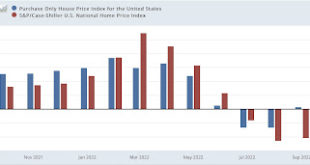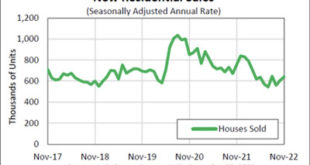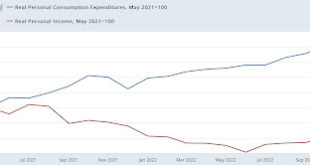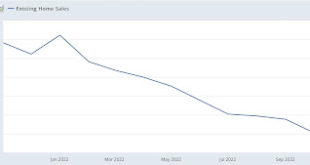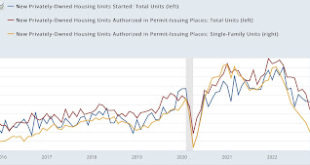A New Wellbeing Rankings Study David G. Blanchflower of Dartmouth and Alex Bryson of University College in London have just published a paper at NBER 30759 “Wellbeing Rankings,” which provides some provocative ideas and data on various possible measures of well-being in societies. This reflects dissatisfaction with the tendency to use a single measure, “life satisfaction” on finds in the happiness literature, with ranks of nations widely...
Read More »Further evidence of real declines since summer
House price indexes decline, unchanged in October; further evidence of real declines since summer The Case Shiller national house price index declined another -0.3% in November, and is now up 9.2% YoY, compared with a peak of +20.8% YoY in March (note that is in line with my rule of thumb that a decline of 1/2 or more in YoY growth over the past 12 months indicates a series has peaked and rolled over). The FHFA purchase only house price index...
Read More »New Deal democrat’s weekly indicators for December 19 – 23
Weekly Indicators for December 19 – 23 at Seeking Alpha My Weekly Indicators post is up at Seeking Alpha. Coincident indicators continue to ever so microscopically worsen – but not yet in recession territory; while there is an increasing suggestion from the long leading indicators that a recession could be relatively short. Provided, of course, that the Fed takes the hint. As usual, clicking over and reading will bring you up to the virtual...
Read More »New home sales for November: at last, a bright spot!
New home sales for November: at last, a bright spot! (relatively speaking) New home sales are very volatile, and heavily revised. But they frequently are the first housing metrics to turn. And November’s new home sales report suggests that they may indeed have made their low. Last month new home sales increased to 640,000 annualized, from a downwardly revised 607,000 (vs. the original 632,000) in October. Here’s what the past year looks like...
Read More »Real personal income and spending
Real personal income and spending hold up (thank you, lower gas prices!) but still consistent with onset of recession This morning’s report on personal income and spending for November shows why I pay more attention to real retail sales as a forecasting tool. First, to the data: personal income increased nominally by 0.3% in November, while nominal spending increased only 0.1%. Since the deflator for the month was 0.1%, that means real income...
Read More »Durable goods orders appear to have peaked
Durable goods orders appear to have peaked [Note: I’ll post about personal income and spending, as well as new home sales, later.] I normally don’t pay much attention to the monthly durable goods report, but this morning’s report for November appears significant. That’s because durable goods spending has been one of the few short leading indicators to have continued to improve – until now. Here’s the long term view: New factory orders...
Read More »They will give us a lead on when the Sahm rule for recessions may be triggered
Initial claims continue in range; why they will give us a lead on when the Sahm rule for recessions may be triggered Initial claims ticked up 2,000 last week to 216,000. The 4 week moving average declined 6,250 to 221,750. Continued claims, with a one week delay, declined 6,000 to 1.670 million: To state the obvious continued good news, it remains the case that almost nobody is getting laid off. Also continued good news is that claims, and...
Read More »November existing home sales: prices have unequivocally turned down
November existing home sales: prices have unequivocally turned down – by New Deal democrat Existing home sales do not have much actual economic impact, since the primary economic activity generated by housing is the construction. But they do help tell us a great deal about pricing. For the record, sales continued their relentless decline this year, down to 4.09 million on an annualized basis, down almost 1/3rd from their recent February...
Read More »Usefulnomics — an example
by David Zetland (originally published at The one-handed economist) I’m not shy about criticizing the weakest elements of economics (there are many), so it’s sometimes a good idea to remind myself (and you!) of the strengths of economics, i.e., those characteristics that make it useful. Here’s an example based on a test-question I just asked: You are a baker facing higher energy (natural gas) prices. Higher prices result from (choose one...
Read More »November housing permits and starts: the biggest news is not even a headline
November housing permits and starts: the biggest news is not in the headlines – by New Deal democrat The report on housing construction for November was very much a tale of two very different trends – and the most important one will almost certainly be under-reported. Housing permits issued declined to 1.342 million annualized, the lowest number since June 2020, and before the pandemic the lowest since July 2019. The even more reliable...
Read More » Heterodox
Heterodox

